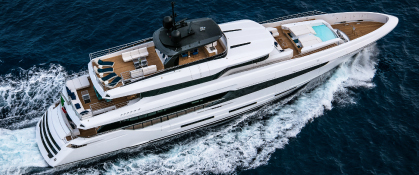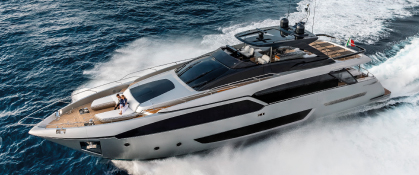
Custom Line launched the first hull of the Navetta 30 with exterior design by Filippo Salvetti. In parallel, he worked on an equally important project - the flagship Ferretti Yachts 1000. How did the man-orchestra manage to pull it off? He tells us.





Filippo Salvetti came to yacht design by a lucky chance. He studied architecture at the Politecnico di Milano and started out in the office of one of his teachers before joining Momo Design. This is one of the most famous brands in Italy for helmets, shoes and accessories for motorcycling. It has its own circle of devoted fans, not all of whom ride motorcycles themselves. They just love Momo's brutal style and technology.
Filippo met the very same Mauro Micheli and Sergio Beretta of Officina Italiana Design, who worked on all of the Riva Yachts models of our time and.... since then, yachts have become the main thing for him.
Salvetti says that he loved to watch Mauro when he was sketching the next Riva beauty and, like a sponge, absorbed all the new knowledge.
He had worked at Officina Italiana Design for eight years and in 2009 decided to start his own business and founded Neo Design with Marco Biaggi, who later left to design sailing yachts at Persico Marine. His collaboration with the Ferretti Group began in 2014 with the Ferretti Yachts title brand.

In 2020, Filippo Salvetti unveiled his first project for Custom Line, the 28.43-meter-long Navetta 30, a compact superyacht for ten guests and certified as a CE CLASS A vessel.
In the exterior of this compact yacht with flybridge, Salvetti has emphasized lightness and dynamism by increasing the area of panoramic glazing in the superstructure. He highlighted the horizontal lines of the three decks, thus visually lengthening the profile of the yacht. He has created a single multi-level space of outdoor and indoor areas, from the flybridge to the beach club at the stern, fitted with the Ferretti Group's patented DMT (Dual Mode Transom) panel. For sure, each and every guest will find his or her favorite activity and personal space on this yacht.
Tests have shown that the Navetta 30 is a quiet and comfortable yacht. In addition to state-of-the-art insulation materials and fillings, the yacht uses a “floating” floor so that no transmission noise, footsteps, or conversations in neighboring rooms would reach the guest areas.
The lighting system for the open spaces, saloon, and cabins has been carefully considered. Salvetti has made light a full-fledged component of the complex interior design. The lighting of architectural elements such as spiral staircases or windows has become an integral part of the yacht's design The extensive use of dimmers has allowed for endless experiments with the level of illumination.

You have worked with the Ferretti Group before, but the Navetta 30 project became your debut for Custom Line. How can you define the difference between this brand and all the others?
Although Ferretti Yachts is one of the leading yacht brands, working on the new Custom Line model has allowed us to be more daring in exterior design. Custom Line has always excelled at combining manufacturing efficiency with unparalleled attention to detail. The shipyard is the epitome of the 'Made in Italy' approach, based on the centuries-old heritage of Italian shipbuilders. However, it can be said for sure that it has outdone itself in the construction of the first hull of the Navetta 30, creating a true jewel in the yacht-building industry and opening a new chapter in its own history.
What was the most challenging part in designing the Custom Line Navetta 30?
For the Navetta 30 project, it was decided to base the design on projected volumes and on yacht performance levels and comfort standards, which had previously only been available on much larger models. This was the greatest challenge: to find a harmonious, flexible, and intelligent way to shape the design guidelines to reduce freedom of interpretation and optimize the product by reducing its volumes.

How do you find points of contact between the designer and the technicians?
Fortunately, both Ferretti Yachts and Custom Line have always maintained an excellent, creative relationship between all those involved in product development, which was fundamental to the success of the project. Equally important was the presence of the head (Ferretti Group's Head of Product and Development, Piero Ferrari- Yachting), coordinating the work of the designers with the technical department, a man with technical knowledge and a strong aesthetic sense.
How different were your first drawings of the CL Navetta 30 from the final result?
In fact, the result was in line with the original design ideas. The new solutions were aimed at accommodating as much interior volume as possible. In general, however, I change a lot of things as I progress through my projects. Some details I may add or take away, but, if we believe that an idea is inherently winning, then its essence should remain the same. This was the case with the CL Navetta 30.

You worked almost simultaneously on the Ferretti Yachts 1000 and the Custom Line Navetta 30. How did you manage to switch between projects?
Combination of two factors. What I have been taught as a designer and the creative philosophy in my studio are geared towards running several projects at the same time and working for different brands. Technically, it's not difficult, since our workflow is well-established. I believe that, when working on the project for any shipyard, the final result should demonstrate respect for the brand and its roots. It is crucial. A new project can, of course, have recognizable features of my own style and aesthetic sense, but first and foremost a yacht is a product, and it must reflect the style and objectives of the shipyard, not its author. The real challenge in designing for brands such as Ferretti Yachts and Custom Line is not to try to revise their traditions within the framework of one project (this is both fruitless and wrong) but to create an individual and unique image of the model, but without losing the generic features of the brand. I would like to note that changes in the concept of any yacht brand are necessary and natural, but they should be evolutionary. Old and new techniques are combined with each other, preserving the distinctive features of the brand, and new concepts and characteristics are gradually added to the product.

What is important to customers in yacht design today?
It depends a lot on the type of client and the type of product offered. However, in general, we notice that customers are becoming more prepared and also more discerning. Their expectations are getting higher and higher, and they are also becoming more “globalized” as they travel a lot around the world. They know how to compare and are used to high standards of comfort.
The functionality, elegance, and aesthetics of each project are evaluated by them with close scrutiny. It is also becoming increasingly clear that design is not only beauty but also a practical tool that can create not only an object of beauty but also a place to live in absolute peace and comfort. We are definitely witnessing a reduction in the age of customers who can afford luxury products. And this fact may explain why new products are constantly emerging in the world of yachting, offering alternative ways to recreate on the water.

































